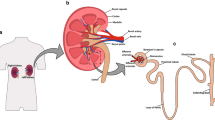Abstract
Gentamicin is a member of aminoglycosides, which has represented highly effective antimicrobial agents especially in Gram-negative infections despite their toxic effects in the kidney. Rapid diagnosis is vital to preserve renal function and to slow down renal injury. Owing to the poor sensitivity and specificity of serum creatinine (SCr) and blood urea nitrogen (BUN), new biomarkers for earlier and more accurate detection are needed. The aim of our study was to determine whether kidney injury molecule-1 (KIM-1) and neutrophil gelatinase-associated lipocalin (NGAL) may be useful biomarkers in the assessment of gentamicin-induced nephrotoxicity in rats. In this study, the two biomarkers of renal toxicity were assessed via ELISA, quantitative real-time PCR, and immunohistochemistry in rats treated with gentamicin for up to 7 days. Repeated administration of gentamicin to male SD rats for 1, 3, or 7 days resulted in a dose- and time-dependent increase in the expression of KIM-1 and NGAL. Changes in gene and protein expressions were found to correlate with the progressive histopathological alterations and preceded effects on traditional clinical parameters indicative of impaired kidney function. Both of the biomarkers are supported to be used as sensitive indicators of acute kidney injury caused by gentamicin.



Similar content being viewed by others
References
Badreldin HA, Mohammed AZ, Gerald B, Abderrahim N (2011) Experimental gentamicin nephrotoxicity and agents that modify it: a mini-review of recent research. Basic Clin Pharmacol Toxicol 109:225–232
Gururao H, Manoj K, Komal R, Punit K, Alagiri S (2012) Aminoglycoside induced nephrotoxicity: molecular modeling studies of calreticulin-gentamicin complex. J Mol Model 18:2645–2652
Ali BH (2003) Agents ameliorating or augmenting experimental gentamicin nephrotoxicity: some recent research. Food Chem Toxicol 41:1447–1452
Tobias CH, Philip H (2011) Biomarkers for drug induced renal damage and nephrotoxicity. The AAPS Journal 13:615–631
Vikash S, Luis MV, Abdulla KS (2013) Urinary tubular protein-based biomarkers in the rodent model of cisplatin nephrotoxicity: a comparative analysis of serum creatinine, renal histology, and urinary Kim-1, NGAL, and NAG in the initiation, maintenance, and recovery phases of acute kidney injury. J Investig Med 61:564–568
Josef SO, Frank D, Sean T, Elias P, André C, Pablo V, Frank S, Andreas M, Olivier G et al (2010) A panel of urinary biomarkers to monitor reversibility of renal injury and a serum marker with improved potential to assess renal function. Nat Biotechnol 28:486–496
Luyang G, Takahisa T, Yoshio E, Takahiro D, Hiroshi S (2012) Shedding of kidney injury molecule-1 by membrane-type 1 matrix metalloproteinase. J Biochem 152:425–432
Vishal SV, Josef SO, Frank D, Fitz BC, Victoria R, Sean T, Nagaraja M, Douglas T, David G, Daniel JH, Norma AB, Estelle M, Elias P, André C, Jacky V, Gérard M, Peter LG, Frank DS, Joseph VB (2010) Kidney injury molecule-1 outperforms traditional biomarkers of kidney injury in preclinical biomarker qualification studies. Nat Biotechnol 28:478–485
Venkata S, Kazumi I, Chang W, Li Y, Stephen CM, Joseph V (2012) Novel assays for detection of urinary Kim-1 in mouse models of kidney injury. Toxicol Sci 555:32–38
Soon HK, Moo YP, Jin SJ (2013) KIM-1 expression predicts renal outcomes in IgA nephropathy. Clin Exp Nephro 17:359–364
Cheng Z, Panfilo O, Jeffrey F, Kevin R, Ryan W, Frank G, Carol R (2010) Structural characterization of glycoprotein NGAL, an early predictive biomarker for acute kidney injury. Carbohydr Res 345:2252–2261
Davide B, Valentina D, Giuseppe C, Susanna C, Antoine B, Antonio L, Michele B (2008) Neutrophil gelatinase-associated lipocalin (NGAL) as a marker of kidney damage. Am J Kidney Dis 52:595–605
Neal P, Andong Q, Maria H, Thomas LN, Prasad D, Jonathan B (2012) NGAL-Siderocalin in kidney disease. Biochim Biophys Acta 1823:1451–1458
Anna W, Walentyna Z, Katarzyna T, Joanna M (2010) Neutrophil gelatinase-associated lipocalin (NGAL): a new marker of cyclosporine nephrotoxicity? Pediatr Nephro 25:889–897
Sandhu JS, Sehgal A, Gupta O, Singh A (2007) Aminoglycoside nephrotoxicity revisited. J Indian Acad Clin Med 8:331–333
Yuzhao Z, Vishal SV, Ronald PB, Jun Z, Barry AR, Karol LT, Terry JM, Joseph VB, Peter LG (2008) Comparison of kidney injury molecule-1 and other nephrotoxicity biomarkers in urine and kidney following acute exposure to gentamicin, mercury, and chromium. Toxicol Sci 101:159–170
Eva R, Dana H, Kai B, Klaus W, Wolfgang D, Angela M (2008) Evaluation of putative biomarkers of nephrotoxicity after exposure to Ochratoxin A in vivo and in vitro. Toxicol Sci 103:371–381
Anna W, Katarzyna TJ, Wojciech D, Walentyna ZZ, Elizbieta KS (2011) KIM-1 and NGAL: new markers of obstructive nephropathy. Pediatr Nephrol 26:579–586
Zhan-Kui J, Pu-Xun T, Xu-Zhen W, Wu-Jun X (2013) Kidney injury molecule-1 and osteopontin: new markers for prediction of early kidney transplant rejection. Mol Immunol 54:457–464
Zhang PL, Rothblum LI, Han WK, Blasick TM, Potdar S, Bonventre JV (2008) Kidney injury molecule-1 expression in transplant biopsies is a sensitive measure of cell injury. Kidney Int 73:608–614
Zaid A, Amjad S, Rima S, Omri N, Hoda A, Bishara B, Victor F, Igor S, Abeer A, Ofer N (2013) Urinary NGAL and KIM-1: biomarkers for assessment of acute ischemic kidney injury following nephron sparing surgery. J Urol 189:1556–1559
Petra V, Sofie S, Erio BT, Adriana L, Manisha S, Nich G, Loes V, Krisitel B, Ann L (2012) Tissue Kim-1 and urinary clusterin as early indicators of cisplatin-Induced acute kidney injury in rats. Toxicol Pathol 40:1049–1062
Acknowledgments
The research was supported by the Twelfth Five-Year Plan of National Science and Technology Major Project(2011ZX09301-001), Sichuan Province Basic Research Program (2011JY005), the Youth Innovation Research Team Foundation of Sichuan Province Science and Technology Bureau (2013TD0015) .
Author information
Authors and Affiliations
Corresponding authors
Additional information
Qi-hui Luo and Meng-lu Chen authors are contributed equally to this work.
Rights and permissions
About this article
Cite this article
Luo, Qh., Chen, Ml., Sun, Fj. et al. KIM-1 and NGAL as biomarkers of nephrotoxicity induced by gentamicin in rats. Mol Cell Biochem 397, 53–60 (2014). https://doi.org/10.1007/s11010-014-2171-7
Received:
Accepted:
Published:
Issue Date:
DOI: https://doi.org/10.1007/s11010-014-2171-7




